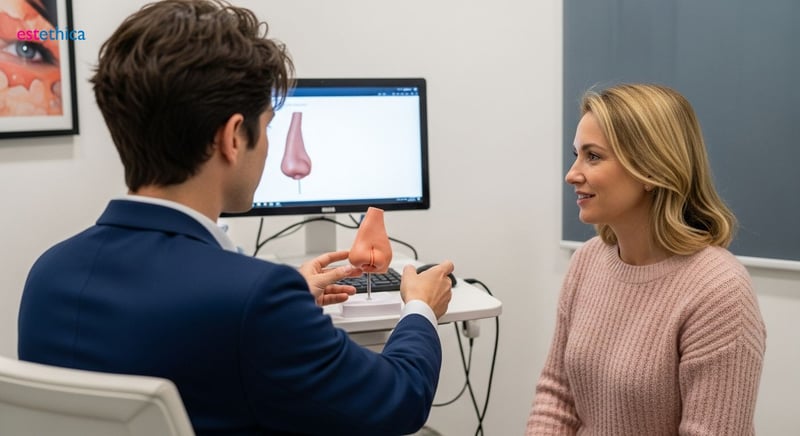Unlock Your Best Profile: The Ultimate Rhinoplasty Guide
Enhance your profile with confidence. Dive into the ultimate guide to rhinoplasty today.
Rhinoplasty, commonly referred to as a nose job, is not just about enhancing the aesthetic appeal of your nose. This guide explores how rhinoplasty can improve functionality and boost confidence. Whether you're considering this surgery for cosmetic reasons or medical necessity, understanding the procedure, recovery, and selecting the right surgeon is crucial.
Rhinoplasty: Reshaping Beyond Aesthetics
Correcting Nasal Imperfections Through Rhinoplasty
Rhinoplasty is a pivotal surgical intervention, adept at refining the aesthetic and functional attributes of the nose. Many seek rhinoplasty to alleviate breathing complications, commonly linked to a deviated septum, highlighting the procedure's dual benefits. Others are driven by the desire for aesthetic enhancement, aiming to achieve a more harmonious facial symmetry. The positive outcomes of rhinoplasty often extend beyond mere physical alterations, significantly bolstering self-esteem and fostering an improved sense of well-being.
The skills of the surgeon in cosmetic nose surgery during a rhinoplasty are crucial for those who want to improve their appearance. Rhinoplasty is favored as a definitive solution by those who have a deviated septum or poor nasal aesthetics. One in five rhinoplasty patients report a marked increase in their confidence levels post-surgery.
Considering Rhinoplasty? What to Expect:
- Initial Assessment: A thorough evaluation to determine suitability and discuss desired outcomes, ensuring alignment with cosmetic and functional goals.
- Surgical Procedure: The precise reshaping of nasal structures, addressing both aesthetic preferences and breathing functionality.
- Recovery and Aftercare: Guidance on post-operative care to facilitate healing and ensure optimal results, with a focus on minimizing discomfort.
For individuals contemplating a "Nose Job", understanding these facets is essential. Rhinoplasty, beyond mere cosmetic enhancement, embodies a transformative journey toward improved nasal function and enhanced self-perception.
Key Steps in Rhinoplasty Procedure
- Anesthesia Administration: Ensuring patient comfort and relaxation throughout the surgical process, usually involving general or local anesthesia.
- Nasal Reshaping: Meticulously sculpting the nose, addressing deformities, and refining contours to achieve the desired aesthetic result.
- Closure and Support: Closing incisions and applying splints or packing to stabilize the nose during the initial healing phase, critical for long-term success.
These steps are integral to achieving successful nasal reshaping, aligning form and function seamlessly. Rhinoplasty offers an increasingly popular option for both aesthetic and functional nasal correction.

Cosmetic Nose Surgery: Exploring Options and Expectations
Navigating Choices in Cosmetic Nose Surgery
Cosmetic nose surgery encompasses a spectrum of approaches aimed at refining the nose’s appearance to harmonize with overall facial aesthetics. From conventional surgical rhinoplasty to less invasive non-surgical alternatives, individuals have diverse options. Non-surgical rhinoplasty, often referred to as a "liquid nose job", utilizes fillers to subtly reshape the nose without incisions, making it a popular choice for those seeking minor adjustments. This method offers a quicker recovery time compared to traditional surgery, but it's essential to consult with a board-certified surgeon to determine the most suitable approach for individual needs and desired outcomes. The selection of a skilled surgeon is paramount, especially when considering specialized procedures like ethnic rhinoplasty, where preserving unique cultural features while achieving aesthetic goals is crucial.
The initial consultation plays a pivotal role in setting realistic expectations. According to recent studies, about 30% of individuals seeking cosmetic nose surgery are primarily concerned with addressing breathing difficulties alongside aesthetic improvements. A clear discussion of goals and surgical techniques ensures alignment between patient expectations and achievable results.
Key Considerations Before Cosmetic Nose Surgery
- Comprehensive Consultation: Engage in a detailed discussion with the surgeon about your aesthetic goals and any functional concerns, such as breathing issues.
- Understanding Surgical Techniques: Familiarize yourself with the various surgical and non-surgical methods available, including their respective benefits and limitations.
- Assessing Suitability: Determine if you are an ideal candidate for the chosen procedure based on your overall health and specific nasal anatomy.
Understanding these considerations helps navigate the complexities of cosmetic nose surgery and ensures a well-informed decision-making process.
Essential Steps for a Successful Cosmetic Nose Surgery
- Detailed Evaluation: Undergo a thorough pre-operative assessment, including imaging and physical examination, to identify specific areas for improvement.
- Customized Surgical Plan: Collaborate with your surgeon to develop a tailored surgical plan that addresses your unique needs and aesthetic preferences.
- Post-Operative Care: Adhere strictly to the post-operative care instructions provided by your surgeon to facilitate optimal healing and achieve desired results, with particular attention during rhinoplasty recovery in the summer or allergy season.
Adhering to these steps is crucial for achieving a satisfactory outcome in cosmetic nose surgery, promoting both aesthetic enhancement and improved nasal function.

Rhinoplasty Recovery: A Comprehensive Timeline
Immediate Post-Operative Care After Rhinoplasty
The initial days following rhinoplasty are crucial for setting the stage for optimal healing. Directly after surgery, patients can anticipate some degree of swelling and bruising around the nose and eyes. Managing pain effectively during this immediate phase is paramount, often achieved through prescribed medication. It’s common for surgeons to place a splint and/or packing inside the nose to provide support and maintain the new shape as it heals. Keeping the head elevated, even while sleeping, helps to minimize swelling. About 80% of swelling typically subsides within the first few weeks, significantly improving comfort and appearance.
Adhering strictly to your surgeon's aftercare instructions is essential to ensure the best possible outcome. Minor discomforts should be addressed promptly, and any unusual symptoms, such as excessive bleeding or signs of infection, should be immediately reported to your surgical team. Patients are advised to avoid strenuous activities, which could disrupt the healing process. Simple activities like reading or watching TV are encouraged to promote relaxation.
Key Steps for Managing Immediate Recovery
- Pain Management: Utilizing prescribed pain medication to alleviate post-operative discomfort.
- Swelling Reduction: Keeping the head elevated and applying cold compresses to minimize swelling and bruising.
- Nasal Care: Following specific instructions for cleaning and maintaining nasal packing and splints.
Proper management in this critical phase can greatly diminish complications and enhance the overall Rhinoplasty recovery experience.
Navigating the Rhinoplasty Recovery Milestones
- Initial Week: Focus on rest, managing discomfort, and adhering to medication schedules.
- Weeks Two to Four: Gradual reduction in swelling; splint and sutures are typically removed.
- Months One to Six: Continued refinement of nasal contours, with subtle changes becoming apparent.
Understanding these phases is crucial for aligning patient expectations with the actual healing timeline after undertaking Nose Surgery. Proper adherence to these milestones helps ensure a smoother recovery and satisfactory results from your Rhinoplasty.

Finding the Best Rhinoplasty Surgeon for Your Needs
Essential Criteria for Selecting Your Rhinoplasty Surgeon
Choosing the right surgeon for your "Nose Surgery" is crucial, influencing both the functional and aesthetic success of the procedure. Beyond basic qualifications, it's essential to examine a surgeon’s specific expertise in rhinoplasty, focusing on their experience with cases similar to your own. Look for board certification from reputable surgical boards, ensuring they have met rigorous standards of training and competence. Delve into their history of patient outcomes, carefully reviewing before-and-after photos to gauge their aesthetic style and the consistency of their results.
During initial consultations, assess the surgeon's communication style. A good surgeon should clearly explain the proposed surgical plan, potential risks (related to male rhinoplasty or ethnic rhinoplasty), and realistic outcomes, addressing all your concerns openly. A surgeon who listens attentively and values your input is more likely to deliver results that align with your expectations. Around 65% of patients emphasize the importance of a surgeon’s communication skills as a deciding factor. Trust your instincts—a strong rapport and mutual understanding are vital for a successful partnership.
Key Factors in Surgeon Selection
- Credentials and Expertise: Look for board certifications and extensive experience in rhinoplasty specifically.
- Portfolio Review: Examine before-and-after photos to evaluate aesthetic results and consistency.
- Communication Skills: Ensure the surgeon clearly explains the procedure, potential risks, and outcomes.
Considering these factors will help ensure you select a surgeon who meets your needs and understands your desired outcomes for Rhinoplasty.
Steps to Evaluating a Rhinoplasty Surgeon
- Initial Consultation: Schedule consultations with multiple surgeons to discuss your goals and assess their approach.
- Verify Credentials: Confirm the surgeon's certifications and affiliations with reputable medical organizations.
- Patient Testimonials and Reviews: Research patient feedback and reviews to gain insights into the surgeon's bedside manner and results.
Following these steps will guide you in making an informed decision when choosing a surgeon for your Rhinoplasty or "Nose Job", ensuring they align with your expectations and needs.
Understanding Rhinoplasty: A Comprehensive Guide
Expert Nasal Sculpting with Enhanced Functional Outcomes
Optimal Rhinoplasty Recovery Through Personalized Aftercare
Frequently Asked Questions
What are the primary benefits of undergoing Rhinoplasty?
What does the Rhinoplasty recovery process typically involve?
How do I find the Best Rhinoplasty Surgeon Near Me for my specific needs?
What is Non-Surgical Rhinoplasty, and who is it suitable for?
Achieve your aesthetic goals with estethica's world-class services and expert care.
📞 Book Your Free Consultation!